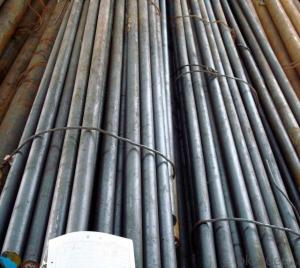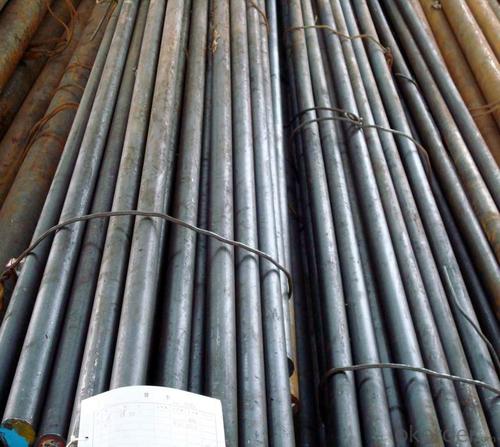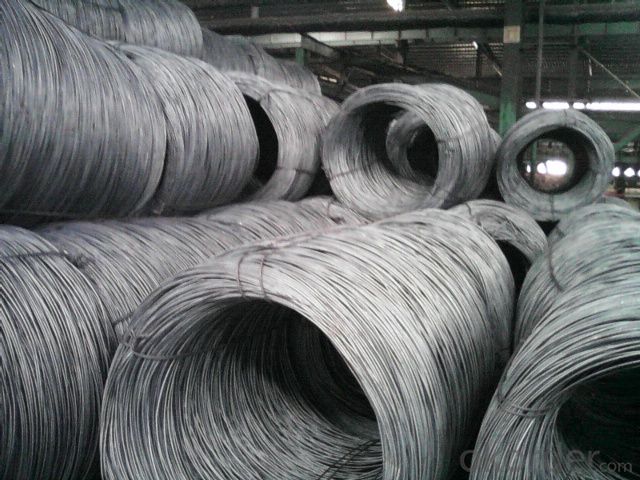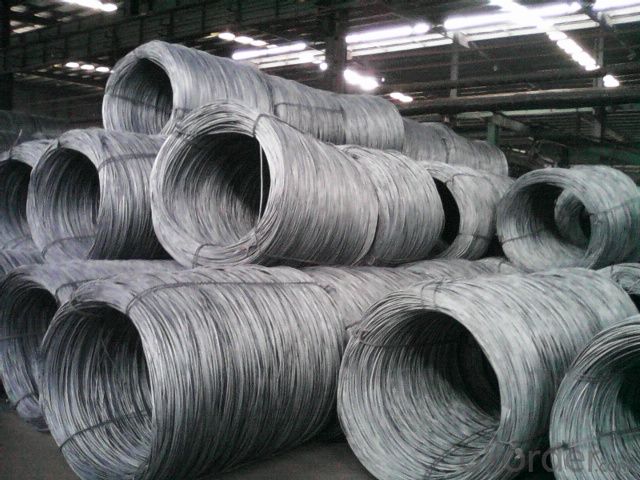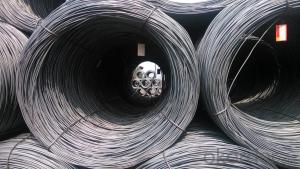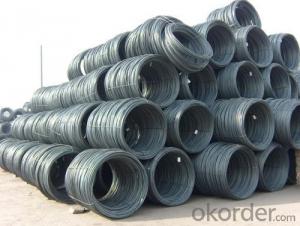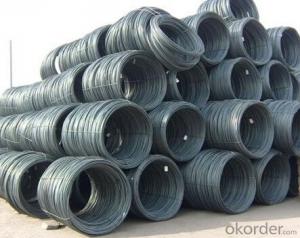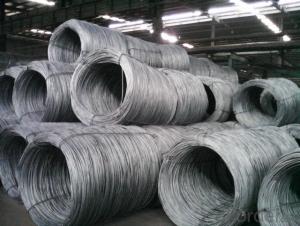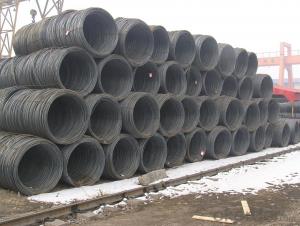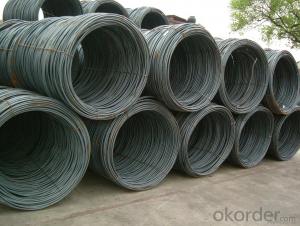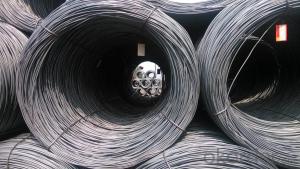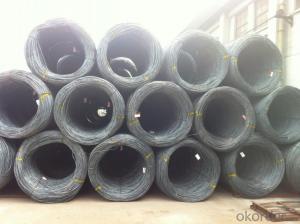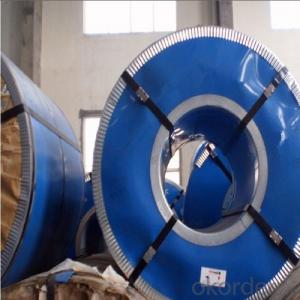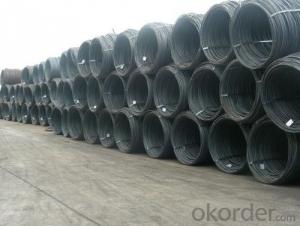Hot Rolled Steel Wire Rod Coil Many Sizes
- Loading Port:
- China Main Port
- Payment Terms:
- TT or LC
- Min Order Qty:
- -
- Supply Capability:
- -
OKorder Service Pledge
OKorder Financial Service
You Might Also Like
Product Description:
OKorder is offering Wire Rod at great prices with worldwide shipping. Our supplier is a world-class manufacturer of steel, with our products utilized the world over. OKorder annually supplies products to European, North American and Asian markets. We provide quotations within 24 hours of receiving an inquiry and guarantee competitive prices.
Product Applications:
After hot-rolled the products shaped into coil and delivery as finished product, including round, square, rectangular, hexagonal and so on. Since most of the products are round, it is generally called wire rod. Carbon steel wire rod is widely used in construction and manufacturing. Carbon steel wire rod is mainly used for reinforcement of reinforced concrete and welded structure or reprocessed (roberts , nail, etc.) materials, especially used to produce wire drawing, welding electrode, nails, spring, electronic, precise machinery parts and so on.
Product Advantages:
OKorder's Wire Rod are durable, strong, and resist corrosion.
Main Product Features:
· Premium quality
· Prompt delivery & seaworthy packing (30 days after receiving deposit)
· Corrosion resistance
· Can be recycled and reused
· Mill test certification
· Professional Service
· Competitive pricing
Product Specifications:
Steel Grade: Q195/235, SAE1006-1018B Standard: ASTM, GB
Diameter: 5.5mm, 6.5mm, 7mm,8mm,9mm,10mm,12mm,14mm
Type: in coil, coil weight around 2MT Alloy or Not: Alloy
Technique: Hot Rolled Place of Origin: China Mainland
Surface: round, no twisted, light and smooth Brand Name: HSKY
Chemical Composition: (Please kindly find our chemistry of our material based on Q195、Q235A and Q235B as below for your information)
| Trademark | Rank | Chemical composition (quality score) % | |||||||||||||||||||||
| C | Si | Mn | S | P | |||||||||||||||||||
| ≤ | ≤ | ≤ | |||||||||||||||||||||
| Q195 | 0.06-0.12 | 0.30 | 0.25 | 0.050 | 0.045 | ||||||||||||||||||
| Q235 | A | 0.14-0.22 | 0.30 | 0.30-0.65 | 0.050 | 0.045 | |||||||||||||||||
| Q235 | B | 0.12-0.20 | 0.30 | 0.30-0.70 | 0.045 | 0.045 | |||||||||||||||||
Images:
Q1: How soon can we receive the product after purchase?
A1: Within three days of placing an order, we will begin production. The specific shipping date is dependent upon international and government factors, but is typically 7 to 10 workdays.
Q2: What makes stainless steel stainless?
A2: Stainless steel must contain at least 10.5 % chromium. It is this element that reacts with the oxygen in the air to form a complex chrome-oxide surface layer that is invisible but strong enough to prevent further oxygen from "staining" (rusting) the surface. Higher levels of chromium and the addition of other alloying elements such as nickel and molybdenum enhance this surface layer and improve the corrosion resistance of the stainless material.
Q3: Can stainless steel rust?
A3: Stainless does not "rust" as you think of regular steel rusting with a red oxide on the surface that flakes off. If you see red rust it is probably due to some iron particles that have contaminated the surface of the stainless steel and it is these iron particles that are rusting. Look at the source of the rusting and see if you can remove it from the surface.
Images:
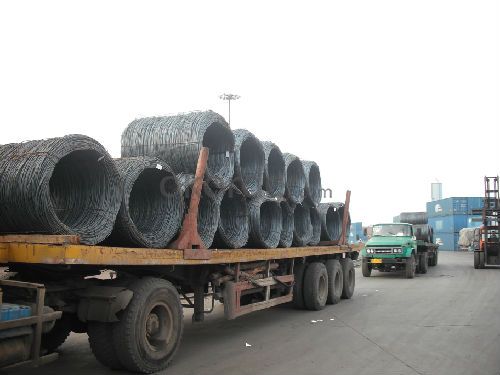
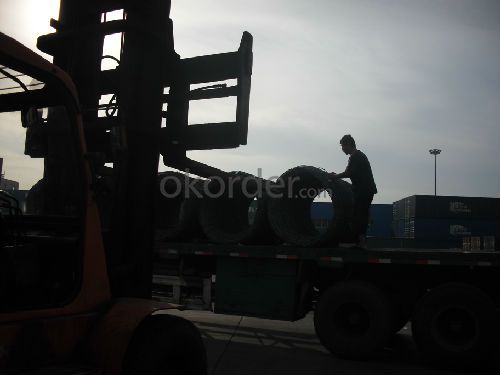
- Q: What are the different surface defects that can occur during wire drawing?
- Surface defects that may impact the wire's quality and performance can occur during wire drawing. Some typical surface defects include: 1. Scratches: These marks or lines become visible on the wire's surface due to abrasive contact with the drawing dies or other equipment during the drawing process. 2. Grooves: Elongated depressions or channels on the wire's surface can form as a result of excessive pressure, improper die design, or wear on the drawing dies. 3. Cracks: High drawing forces, excessive strain, or inadequate lubrication can cause cracks to appear on the wire's surface. These cracks weaken the wire and reduce its mechanical strength. 4. Scale: Oxide layers or impurities on the wire's surface are referred to as scale. This can occur due to insufficient cleaning of the incoming wire or improper heat treatment processes. 5. Flakes: Small metal pieces detach from the wire's surface during the drawing process, resulting in flakes. Material defects, excessive die wear, or improper lubrication can cause this issue. 6. Pitting: Small cavities or depressions form on the wire's surface, which is known as pitting. This is typically caused by corrosion or chemical reactions with the environment or drawing lubricant. 7. Surface roughness: Wire drawing can increase the wire's surface roughness, affecting its appearance and performance in specific applications. To prevent or minimize these surface defects, it is crucial to select appropriate drawing dies, lubrication, control drawing forces and speeds, and regularly inspect and maintain the equipment.
- Q: What are the different types of steel wire rod surface defects and their detection methods?
- During the manufacturing process, various types of defects can occur on the surface of steel wire rods. These defects can have a significant impact on the quality and integrity of the wire rods, so it is crucial to identify and address them before they cause further issues. Here are some common surface defects of steel wire rods and the methods used to detect them: 1. Scale: Oxide layers can form on the surface of wire rods due to exposure to high temperatures during production. Scale can be visually detected by looking for discoloration or by performing a scratch test to see if the scale flakes off easily. 2. Cracks: Surface cracks can be caused by factors like improper cooling, excessive stress, or material defects. Visual inspection is commonly used to detect cracks, but more accurate methods like magnetic particle inspection or ultrasonic testing can also be utilized. 3. Pitting: Pitting refers to small depressions or cavities that form on the surface of wire rods due to corrosion or mechanical damage. Visual inspection is usually sufficient to identify pitting, but techniques like dye penetrant inspection or eddy current testing can be employed for a more detailed examination. 4. Surface roughness: Irregular or uneven texture on the surface of wire rods is known as surface roughness. It can be a result of improper manufacturing processes or inadequate quality control. Visual inspection or the use of a profilometer to measure roughness quantitatively can help detect surface roughness. 5. Inclusions: Non-metallic substances, such as slag, dirt, or oxide particles, can become embedded in the surface of wire rods, causing weak spots or affecting mechanical properties. Visual inspection can identify large inclusions, while microscopic examination or techniques like X-ray inspection can detect smaller or subsurface inclusions. 6. Coating defects: If a wire rod has a coating, defects like peeling, blistering, or uneven thickness can occur. Visual inspection is generally sufficient, but techniques like ultrasonic testing or electrical conductivity measurements can provide a more comprehensive assessment. It is important to note that while visual inspection is commonly used, more advanced non-destructive testing (NDT) methods can offer more accurate and reliable detection of surface defects. By employing a combination of these methods, the identification and rectification of surface defects in steel wire rods can be ensured, ultimately enhancing their quality and performance.
- Q: What are the main factors influencing the choice of steel wire rod order payment terms options?
- The main factors influencing the choice of steel wire rod order payment terms options include the financial stability and creditworthiness of the buyer, the volume and frequency of the orders, the competitive landscape within the industry, the level of trust between the buyer and the seller, and the prevailing market conditions.
- Q: What are the factors that influence the cost of steel wire rod?
- The cost of steel wire rod is influenced by various factors. These factors include the prices of raw materials, particularly iron ore and scrap metal. Fluctuations in these prices can have a significant impact on the cost of production and, consequently, the price of steel wire rod. Additionally, the demand and supply dynamics for steel wire rod in industries such as construction, automotive, and manufacturing can affect its cost. When demand is high and supply is limited, the price tends to rise. Conversely, when demand is low and supply is abundant, the price may decrease. The cost of producing steel wire rod also includes expenses such as labor, energy, transportation, and equipment maintenance. Any changes in these costs, such as wage increases or fluctuations in energy prices, can affect the final price of steel wire rod. Moreover, currency exchange rates play a role in the cost of steel wire rod. Fluctuations in exchange rates can impact the cost of importing raw materials or exporting finished products. If the domestic currency strengthens against foreign currencies, the cost may increase, leading to higher prices. Government policies and regulations, such as tariffs, import/export restrictions, and environmental regulations, can also affect the cost of steel wire rod. These factors can impact the availability of raw materials, increase production costs, or create trade barriers, all of which can influence the final cost. Furthermore, market competition in the steel wire rod industry can impact its cost. Higher competition among manufacturers can result in price competition, leading to lower prices. Conversely, if there are fewer suppliers, they may have more pricing power, resulting in higher prices. It is important to note that these factors are interconnected and can change over time. Therefore, the cost of steel wire rod is subject to constant fluctuation, influenced by a combination of these factors and market dynamics.
- Q: What are the factors that affect the cost of steel wire rod?
- The cost of steel wire rod can be affected by several factors. Firstly, the price of the raw materials used to produce steel wire rod, such as iron ore and scrap metal, heavily influences its cost. Any fluctuations in these raw material prices can directly impact the cost of steel wire rod. Secondly, the cost of producing steel wire rod includes various expenses like labor, energy, and equipment maintenance. Changes in these production and manufacturing costs can affect the overall cost of the product. Thirdly, the demand for steel wire rod plays a significant role in its cost. If there is high demand and limited supply, the price of steel wire rod may increase. Conversely, if there is low demand and excess supply, the price may decrease. Furthermore, market competition among steel wire rod manufacturers can also impact its cost. Intense competition can lead to lower prices as companies strive to attract customers. Conversely, a lack of competition may result in higher prices. Additionally, the cost of transporting steel wire rod from manufacturers to end-users contributes to its overall cost. Factors such as fuel prices, distance, and transportation infrastructure can affect these costs. Moreover, government regulations and policies, like import duties, export restrictions, or environmental regulations, can impact the cost of steel wire rod. Compliance with these regulations may require additional investments, influencing the product's price. Lastly, exchange rate fluctuations can impact the cost of steel wire rod in different countries. Changes in currency values can affect the import and export prices of steel wire rod, influencing its overall cost. To make informed decisions and strategies regarding the cost of steel wire rod, businesses should monitor and understand these factors.
- Q: Can steel wire rod be used in the production of reinforcing bars?
- Yes, steel wire rod can be used in the production of reinforcing bars.
- Q: What are the main factors influencing the choice of steel wire rod order product testing options?
- The main factors influencing the choice of steel wire rod order product testing options include quality control requirements, customer specifications, industry standards, and regulatory compliance. Firstly, quality control requirements play a crucial role in determining the testing options for steel wire rod orders. Manufacturers and suppliers often have their own quality control measures in place to ensure that the products meet the required standards. These measures may include various types of testing such as chemical composition analysis, mechanical property testing, and dimensional inspections. The choice of testing options depends on the specific quality control requirements set by the manufacturer or customer. Customer specifications also heavily influence the testing options for steel wire rod orders. Different customers may have specific requirements or preferences when it comes to the quality and performance of the product. For instance, customers in the automotive industry may have stringent specifications regarding the tensile strength or ductility of the wire rod. In such cases, specialized testing methods may be required to meet these specifications. Industry standards are another important factor in determining the testing options for steel wire rod orders. Various industry organizations and associations set standards and guidelines for the production and testing of steel wire rods. These standards ensure that the products meet the minimum requirements for safety, performance, and reliability. Testing options are chosen based on the specific industry standards that need to be met. Additionally, regulatory compliance is a significant factor influencing the choice of testing options. Steel wire rod manufacturers and suppliers must adhere to the regulations and requirements set by governmental bodies or agencies. These regulations may include specific testing protocols to ensure the safety and quality of the products. Testing options are selected accordingly to meet these regulatory compliance requirements. In summary, the main factors influencing the choice of steel wire rod order product testing options are quality control requirements, customer specifications, industry standards, and regulatory compliance. These factors ensure that the products meet the necessary quality, performance, and safety standards set by manufacturers, customers, and regulatory bodies.
- Q: How is steel wire rod used in the manufacturing of wire shelves?
- Steel wire rod is used in the manufacturing of wire shelves as it serves as the primary raw material. The wire rod is first formed into the desired shape and size, and then further processed to create the wire mesh that forms the shelves. The strength and durability of steel wire rod make it an ideal material for wire shelves, as it can support heavy loads and withstand daily wear and tear.
- Q: What are the different surface defects that can occur in steel wire rod?
- Some common surface defects that can occur in steel wire rods include scale, rust, pits, scratches, cracks, and surface decarburization.
- Q: What are the different types of steel wire rod surface defect prevention and mitigation measures?
- There are various methods to prevent and mitigate surface defects on steel wire rods. Some common measures include implementing proper handling and storage practices, ensuring adequate lubrication during the manufacturing process, utilizing effective cooling techniques, employing surface treatment methods like pickling or phosphating, conducting regular inspections and quality control checks, and implementing corrective actions promptly to address any identified defects. Additionally, proper maintenance of equipment, adherence to industry standards and guidelines, and continuous training and education of personnel are crucial in preventing and mitigating surface defects on steel wire rods.
Send your message to us
Hot Rolled Steel Wire Rod Coil Many Sizes
- Loading Port:
- China Main Port
- Payment Terms:
- TT or LC
- Min Order Qty:
- -
- Supply Capability:
- -
OKorder Service Pledge
OKorder Financial Service
Similar products
Hot products
Hot Searches
Related keywords
